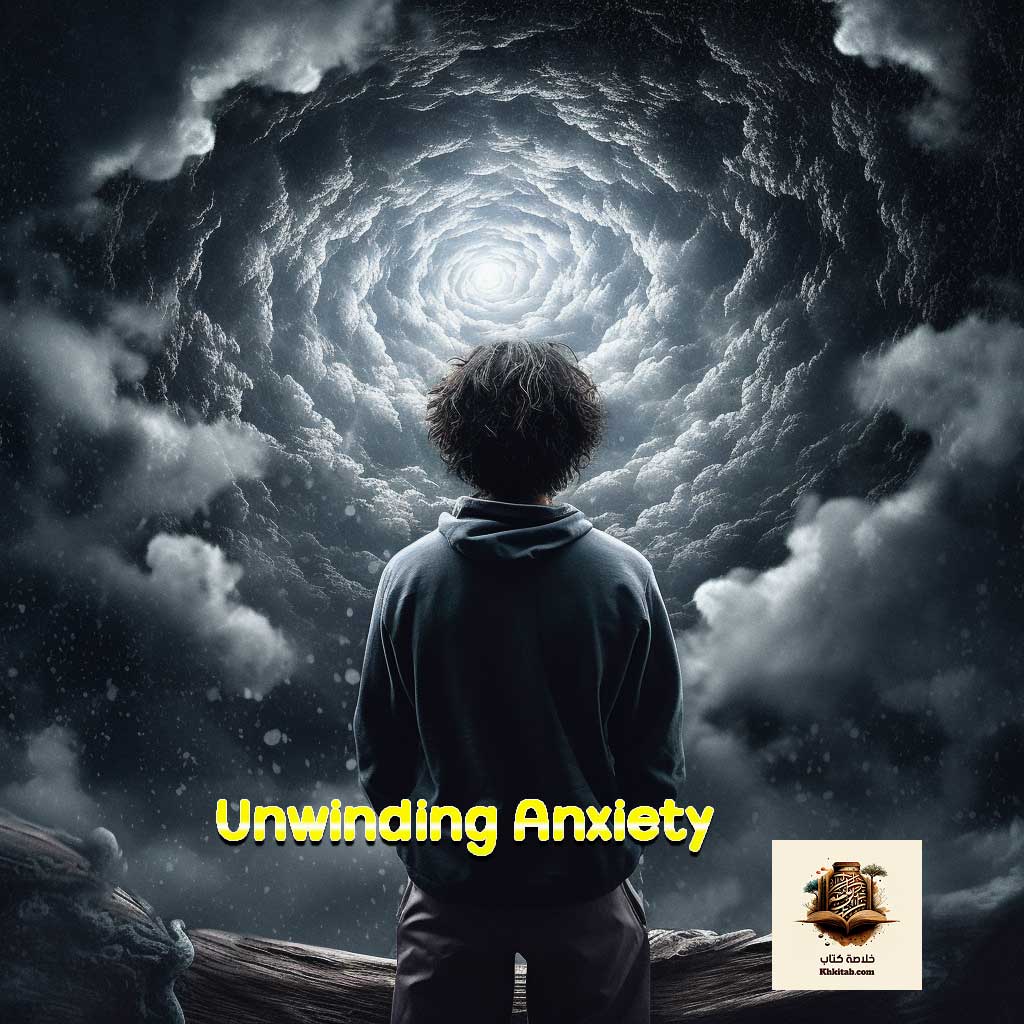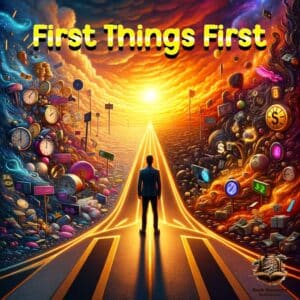
In our contemporary era, anxiety looms large, casting a shadow over many individuals seeking solace and understanding. The book “Unwinding Anxiety” stands out as a pivotal reference in this realm. Authored by Dr. Jud Brewer, this work immerses its readers into a profound exploration of the roots of anxiety and associated concepts. More than just an informational source, it serves as a practical guide, offering tools and techniques readily applicable to daily life. The book bridges ancient wisdom with the latest research in psychology and neuroscience, presenting a comprehensive and detailed perspective on how to “unwind” anxiety and transform it into understanding and awareness.
Table of Contents
How Does the Nature of Anxiety Impact Our Daily Lives?
In today’s fast-paced world, understanding the very nature of anxiety becomes a critical endeavor. The book “Unwinding Anxiety” delves deeply into this concept. Anxiety, as explored in this seminal work, isn’t just a fleeting feeling or a momentary concern. It’s a complex emotional response that has roots in our evolutionary history, often serving as a survival mechanism alerting us to potential threats. However, in the modern context, where physical threats are fewer, this once protective mechanism can often become maladaptive.
Defining anxiety, at its core, is about recognizing it as a multi-faceted emotional and physiological response. It’s not just a mental state; it encompasses physical reactions like increased heart rate, shallow breathing, and muscle tension. This is the body’s way of preparing us to either face the perceived threat (“fight”) or flee from it (“flight”).
Understanding how anxiety manifests in daily life is vital for everyone, whether or not they identify as an anxious person. It’s in the persistent thoughts that keep us awake at night, the inexplicable tension before an important meeting, or even the avoidance of certain places or people that might trigger discomfort. Recognizing these manifestations helps in acknowledging their impact on our decision-making processes, relationships, and overall well-being.
“Unwinding Anxiety” suggests that by truly comprehending the nature of anxiety, individuals can better equip themselves with tools and strategies to navigate their daily lives more effectively. It’s about transforming this understanding into empowerment, ensuring that anxiety doesn’t dominate, but instead informs our responses in a constructive way.
Life Sciences & Medicine – Book Summary (khkitab.com)
How Does the Brain Process and React to Anxiety? Understanding Neural Pathways and Patterns
In our pursuit to comprehend the intricate relationship between the brain and anxiety, “Unwinding Anxiety” by Dr. Jud Brewer offers illuminating insights. The brain, a complex organ responsible for our thoughts, emotions, and actions, plays a pivotal role in the onset and maintenance of anxiety.
At the heart of this relationship is the brain’s neural pathways and patterns. These are essentially the highways and byways of our neural landscape, guiding the flow of information and determining our reactions. When exposed to stressors or threats, certain areas of the brain, like the amygdala, become more active. The amygdala, often referred to as the brain’s “fear center”, processes emotions and sends signals that can initiate the ‘fight or flight’ response.
However, anxiety isn’t solely a product of immediate threats. Often, it’s the result of learned behaviors and neural patterns that have been reinforced over time. For instance, if someone experiences a panic attack in an elevator, the brain might associate elevators with fear, leading to avoidance behaviors in the future. This learned response is a result of neural plasticity, the brain’s ability to reorganize itself by forming new neural connections throughout life.
Furthermore, “Unwinding Anxiety” emphasizes the role of the prefrontal cortex, responsible for decision-making, planning, and impulse control. When anxiety takes hold, this area can become impaired, making it harder for individuals to think clearly and make rational decisions.
In essence, by understanding the intricate neural pathways and patterns associated with anxiety, one can gain a clearer perspective on its roots and manifestation. This knowledge not only demystifies the experience of anxiety but also equips individuals with the information needed to navigate and potentially alter these neural pathways for better mental well-being.
Our Facebook Page – Book Summary
How Do Habit Loops Influence Anxiety? Exploring Triggers, Behaviors, and Rewards
“Unwinding Anxiety” by Dr. Jud Brewer delves deeply into the realm of habit loops and their profound influence on anxiety. But what exactly is a habit loop, and how does it shape our experiences with anxiety?
At its core, a habit loop consists of three main components: the trigger, the behavior, and the reward. This simple yet powerful cycle determines much of our daily routines and reactions.
- Trigger: This is the initial event or situation that sets off the habit loop. It could be something as tangible as a stressful email or as abstract as a specific thought or emotion. For someone with anxiety, common triggers might include social situations, certain memories, or specific external stressors.
- Behavior: Following the trigger, we engage in a particular behavior. This behavior is often an automatic response developed over time. For those grappling with anxiety, behaviors can range from avoidant actions, like staying away from social situations, to physical reactions like increased heart rate or shallow breathing.
- Reward: The final component of the habit loop is the reward. This isn’t necessarily a positive outcome but rather the result that reinforces the behavior. In the context of anxiety, the “reward” might be a temporary relief from anxious feelings when avoiding a certain situation. While this relief might seem beneficial in the short term, it often reinforces the anxiety in the long run.
Dr. Brewer, in “Unwinding Anxiety,” emphasizes the significance of recognizing and understanding these habit loops. By gaining awareness of the triggers, behaviors, and rewards in our lives, we’re better equipped to intervene and potentially reshape these loops. For instance, by identifying and challenging our triggers, or by introducing healthier behaviors, we can slowly dismantle the power these loops hold over us.
In conclusion, understanding the habit loop is instrumental in grasping the intricate mechanisms behind anxiety. By exploring triggers, behaviors, and rewards, we’re not only unveiling the reasons behind our anxious responses but also equipping ourselves with tools to navigate and, ultimately, unwind these complex patterns.
How Can Mindfulness Transform Your Experience with Anxiety?
When we delve into Dr. Jud Brewer’s “Unwinding Anxiety,” a prominent theme emerges: the profound role of mindfulness in tackling the complexities of anxiety. But what makes mindfulness such a transformative tool, and how does it interact with the intricate workings of anxiety?
- Understanding Mindfulness: At its core, mindfulness involves maintaining a moment-by-moment awareness of our thoughts, emotions, bodily sensations, and the surrounding environment. It’s about being present and fully engaged with the now, without judgment. This might seem simple, but in today’s fast-paced world, it’s remarkably challenging.
- Spotting Anxiety’s Triggers with Mindfulness: Anxiety often creeps in without our direct awareness. Through mindfulness, we become keen observers of our internal landscape. This enables us to detect the early signs and triggers of anxiety, giving us the chance to address them before they escalate. Recognizing these patterns, we can respond more skillfully rather than reacting impulsively.
- The Science Behind Mindfulness: Research has demonstrated that practicing mindfulness can reshape the neural pathways in the brain. Specifically, areas associated with attention and emotional regulation, such as the prefrontal cortex, become more robust. Conversely, the amygdala, a region linked to stress and anxiety, shows reduced activity. This means that not only does mindfulness help in the moment, but it also brings about long-term changes in how our brain processes and responds to stress and anxiety.
- Mindfulness as a Tool for Intervention: By cultivating an awareness of our thoughts and feelings, we can approach anxiety from a place of curiosity rather than fear. This perspective shift allows us to examine the root causes of our anxiety. Perhaps we find patterns related to past traumas, negative self-talk, or external pressures. With mindfulness, we can then explore these patterns without becoming overwhelmed, and begin the process of healing and transformation.
- Building Resilience: Over time, as we consistently practice mindfulness, our relationship with anxiety evolves. Instead of viewing it as an insurmountable enemy, we come to see it as a manageable challenge. Our increased self-awareness fosters resilience, allowing us to navigate life’s ups and downs with greater ease and confidence.
In conclusion, “Unwinding Anxiety” paints a vivid picture of how the practice of mindfulness can be a game-changer in our journey with anxiety. By fostering a deeper connection to our inner selves and the world around us, we are better equipped to understand, confront, and ultimately transform the anxious patterns that once held us captive. The path to freedom from anxiety, as Dr. Brewer suggests, may very well lie in the power of being present.
How Can Practical Techniques from “Unwinding Anxiety” Transform Your Relationship with Anxiety?
In the contemporary age where stress and anxiety often seem like constant companions, Dr. Jud Brewer’s “Unwinding Anxiety” offers a beacon of hope. Delving deep into its pages, readers discover not just the science and psychology behind anxiety but also practical techniques that can be seamlessly integrated into daily life. But what makes these techniques stand out?
- Holistic Approach: Brewer recognizes that anxiety isn’t just a mental challenge; it encompasses our emotional, physical, and even spiritual facets. His techniques address anxiety from all these angles, ensuring a comprehensive healing process.
- Root Cause Analysis: Rather than just offering a band-aid solution, “Unwinding Anxiety” provides tools that assist readers in investigating the root causes of their anxiety. By understanding the origins, individuals can effectively mitigate triggers and develop a proactive approach to future stressors.
- User-Friendly Exercises: The book is filled with exercises that cater to individuals across the spectrum, from beginners to those well-versed in mindfulness practices. These exercises are designed to be easily adopted, whether you have five minutes during a lunch break or an hour in the evening.
- Reinforcing Positive Habits: Brewer’s approach goes beyond mere management of anxiety. By introducing techniques that reinforce positive habits, readers are empowered to replace their anxiety-driven patterns with more constructive and sustainable behaviors.
- Science-Backed Strategies: Each technique in the book isn’t just a theoretical concept; it’s rooted in scientific research and evidence. This scientific backing provides readers with confidence in the effectiveness of the methods they’re adopting.
- Adaptability: Recognizing the diverse backgrounds and unique challenges faced by readers, the techniques are adaptable. Whether you’re facing work-related stress, personal anxieties, or broader existential concerns, there’s a tool within “Unwinding Anxiety” that can be tailored to your needs.
- Building Resilience: Beyond immediate relief, Brewer’s techniques aim to bolster resilience. With regular practice, readers can not only tackle present anxieties but also build a stronger foundation to face future challenges with equanimity.
In summary, “Unwinding Anxiety” isn’t just another self-help book. It’s a guide that blends the depth of scientific understanding with the practicality of everyday application. By tapping into its reservoir of techniques, individuals can transform their relationship with anxiety, paving the way for a more harmonious and balanced life.
How Do Real-Life Case Studies in “Unwinding Anxiety” Illuminate the Path to Overcoming Anxiety?
The compelling nature of Dr. Jud Brewer’s “Unwinding Anxiety” isn’t solely grounded in its theoretical approach to anxiety but is significantly enhanced by its integration of real-life case studies. These narratives breathe life into the concepts, making the book not just an academic treatise but a collection of human stories that many readers can resonate with. Let’s dive deeper into the essence of these case studies:
- Relatability and Authenticity: Through firsthand accounts, readers can see the reflection of their own struggles, fears, and hopes. This connection fosters trust and validates the experiences of countless individuals grappling with anxiety.
- Demonstrating Progression: The journey from being overwhelmed by anxiety to learning how to manage and even overcome it is beautifully depicted. This progression acts as a beacon of hope, assuring readers that change is attainable.
- Highlighting Techniques in Action: Abstract concepts become tangible when seen through the lens of real-world applications. These case studies demonstrate how techniques from the book can be employed, adjusted, and optimized based on individual circumstances.
- Diverse Perspectives: Anxiety doesn’t discriminate; it affects people from all walks of life. By presenting a range of narratives, “Unwinding Anxiety” underscores the universal nature of this condition, while also highlighting the unique nuances each individual encounters.
- Challenges and Triumphs: Not every journey is a smooth one. By showcasing both the challenges faced and the triumphs achieved, the case studies provide a balanced view, setting realistic expectations and emphasizing resilience.
- Scientific Validation: Merging personal accounts with science-backed explanations allows for a comprehensive understanding. It’s one thing to claim a technique works, and another to show it in action, backed by both empirical evidence and personal testimony.
- Emotional Connection: Engaging with these real-life stories fosters empathy and emotional connection, making the reading experience more immersive. By the end of each narrative, readers aren’t just passive consumers; they’re emotionally invested in the journey.
In conclusion, the real-life case studies in “Unwinding Anxiety” are pivotal. They transcend mere facts and figures, providing soul to the science. Each narrative serves as an inspiring testament to human resilience, adaptability, and the profound capacity to heal. Through these stories, Dr. Brewer not only educates but also connects on a deeply human level, making his book an essential read for anyone seeking both understanding and solace in their battle against anxiety.
How Does “Unwinding Anxiety” Merge Neuroscience with Ancient Mindfulness Techniques?
In today’s rapidly advancing world, it’s quite fascinating to note the convergence of modern neuroscience and ancient mindfulness practices. Dr. Jud Brewer’s “Unwinding Anxiety” sheds light on this enthralling intersection, offering profound insights into the intricate workings of the brain alongside the transformative power of age-old mindfulness techniques. Let’s delve deeper into this integration:
- Understanding the Brain’s Wiring: At the foundation of Brewer’s work is an in-depth understanding of the brain’s neurocircuitry. He lays out how the brain’s reward systems operate, the neural pathways involved in anxiety, and how habitual thought patterns get entrenched.
- Historical Perspective: Mindfulness, as a practice, has its roots in ancient Buddhist traditions. Brewer not only pays homage to this ancient wisdom but goes on to elucidate how these centuries-old practices align with what we now understand about the brain’s functionality.
- The Role of Awareness: Neuroscience has revealed the significance of self-awareness in breaking undesirable habits. Similarly, the core of mindfulness revolves around cultivating a heightened sense of awareness. Brewer artfully highlights how bringing awareness to one’s patterns, triggers, and behaviors can literally ‘rewire’ the brain.
- Practical Application: What makes “Unwinding Anxiety” stand out is its emphasis on actionable steps. Drawing from both worlds, the book introduces exercises that combine neuroscientific principles with mindfulness practices. This practical approach ensures that readers are not just informed, but empowered to make tangible changes.
- Empirical Evidence: Brewer merges anecdotal experiences rooted in mindfulness practices with empirical evidence from the realm of neuroscience. He references scientific studies that validate the benefits of mindfulness, adding credence to these age-old techniques.
- The Universality of Human Experience: One of the compelling aspects of the book is its underscore on the universality of human experiences. Whether it’s the neural responses observed in brain scans or the peace described in ancient mindfulness texts, there’s a shared human experience that transcends time and technology.
- Holistic Approach: By merging the logical with the spiritual, Brewer promotes a holistic approach to understanding and addressing anxiety. Recognizing that neither domain has all the answers, he champions a more integrated, comprehensive approach.
In conclusion, “Unwinding Anxiety” is a testament to the power of collaboration between the realms of modern science and ancient wisdom. It illustrates that, while our understanding of the brain has grown leaps and bounds, there remains timeless wisdom in ancient practices. By intertwining these two domains, Brewer offers a roadmap that is both scientifically rigorous and deeply human, making it a must-read for those seeking to understand the depths of human psyche and the potential for transformation.
How Will the Future of Anxiety Treatment Unfold According to “Unwinding Anxiety”?
The book “Unwinding Anxiety” by Dr. Jud Brewer is not just a testament to the present understanding of anxiety but also a window into the potential future of its treatment. Leveraging modern neuroscience, ancient mindfulness practices, and decades of clinical experience, Brewer provides a holistic picture that can guide us in understanding the future trajectory of anxiety treatments. Let’s delve into some key takeaways:
- Blending of Old and New: A primary theme of the book is the convergence of age-old mindfulness techniques with contemporary neuroscience. The future will likely witness more of these amalgamations, where traditional practices are given a new life through scientific validation.
- Personalized Interventions: While the underlying mechanisms of anxiety may be consistent, individual experiences can vary. Future treatments may heavily lean on technologies like artificial intelligence to tailor interventions specific to the individual’s neural patterns, life experiences, and triggers.
- Mindfulness Goes Mainstream: Mindfulness, once considered a fringe or alternative approach, will continue to become more mainstream. Its efficacy, highlighted by numerous studies and real-world testimonials as illustrated in the book, suggests that it will form a standard component of future therapeutic techniques.
- Virtual Reality (VR) and Augmented Reality (AR) in Therapy: Imagine undergoing therapy in a controlled virtual environment where triggers can be introduced and managed in real-time. Such experiential treatments, grounded in controlled exposure, can offer transformative experiences for patients.
- Pharmacological Breakthroughs: While the book emphasizes non-pharmacological interventions, the future may see a blend. New drugs, targeting specific neural pathways and working in synergy with mindfulness practices, might be developed to enhance the efficacy of interventions.
- Community-based Healing: Brewer emphasizes the importance of collective experiences in the healing process. The future might observe an increase in community-based therapeutic practices where individuals come together, sharing, and learning from each other’s journeys.
- Technological Integration: The ubiquity of smartphones and wearables can make them potent tools for real-time anxiety management. These devices might be integrated with apps that use biofeedback, offering immediate mindfulness exercises or interventions when signs of anxiety are detected.
- Continued Research and Evolution: The realm of neuroscience is ever-evolving. As our understanding deepens, treatments will become more refined, efficient, and diverse. Continuous research will remain pivotal, ensuring that our approaches remain relevant and effective.
In conclusion, “Unwinding Anxiety” doesn’t just present a snapshot of the current landscape of anxiety treatment but also ignites a conversation about its evolution. The integration of time-tested techniques with groundbreaking innovations promises a future where anxiety is not just managed but transcended. With a perfect blend of compassion, science, and forward-thinking, Dr. Jud Brewer’s insights are foundational for anyone looking to understand the past, present, and future of anxiety treatment.


